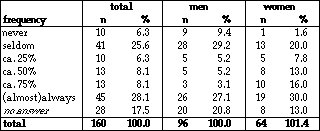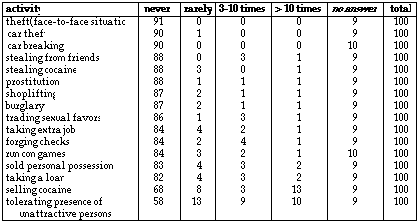Cohen, Peter (1989),
Cocaine use in Amsterdam in non-deviant subcultures. In: Peter Cohen (1990),
Drugs as a social construct. Dissertation. Amsterdam, Universiteit
van Amsterdam. pp. 163-166.
© Copyright 1990 Peter Cohen.
All rights reserved.
13. Craving
Peter Cohen
- 13.1 - Introduction
- 13.2 - Prevalence of cocaine craving
- 13.3 - Extra sources of income to be able to buy cocaine
Table of contents
13.1 Introduction
In his well researched monograph on cocaine, Arnao states that: "a relatively clear impression that emerges from testimonies of several users is, that cocaine dependence is characterized by a difficult to control need when the substance is at hand, which diminishes or disappears when the drug is not around." (Arnao, 1983 transl. P.C.) Our survey permitted a systematic check of his impression. We did not use the concept of dependence to check Arnao's impression, but we asked several questions about craving for cocaine. Craving cocaine can be thought of as a form of 'longing' for cocaine. In fact, we used the Dutch word for longing ('verlangen') in our questionnaire, hoping to avoid the possible moral connotation of the word 'dependence'.
13.2 Prevalence of cocaine craving
Of all respondents 76% knew the feeling of craving for cocaine and reported having experienced it. Another 23% had not experienced craving, and 1% did not answer this question. We wanted to know the age at which the 122 respondents who had experienced craving first met this phenomenon. We computed after how many years of cocaine experience this phenomenon first emerged (table 13.2.a).
Table 13.2.a Age and number of cocaine use years at onset of first craving in percentages (N=122)

The 122 persons who reported craving cocaine were asked if they had this feeling when cocaine was around, when cocaine was not around or both.
This resulted in the following distribution.
Table 13.2.b Current craving for cocaine when it is around and when it is not around (N=117)

Table 13.2.c Craving for cocaine when it is around

Table 13.2.d Craving for cocaine when it is not around

Table 13.2.e Prevalence of cocaine 'ever' having been an obsession

Arnao's impression that craving for cocaine disappears when it is not around cannot be confirmed. It appears less often than when cocaine is around, but the difference is not very large. We do not know, however, how intensities of craving are distributed. It might very well be that, even when people report occurrence of craving when cocaine is not around, the intensity is much lower than when cocaine is around.
We also do not know to which degree craving here reported leads to actual consumption of cocaine. Or, in other words, if craving should be interpreted as a kind of longing that could also be present for apple pie, a sunny beach or an interesting love affair. Because of the important place that craving or 'psychological dependence' on cocaine has in the literature, it would be worthwhile to investigate this matter further. (cf Cohen 1989)
As can be seen in Table 13.2.b. there are only 6 persons who reported having experience with cocaine craving, who do not have this any more, both when cocaine is around and when it is not around. We did not find a difference in reporting craving with users and with ex-users. We did find however a significant relation between level of use during top period and the probability of reporting craving. This means that high level users have a higher probability of experiencing craving than low level users (chi2, p<.025).
Craving for cocaine when it is around is significantly more often found with females then with males (chi2, p<.025).
Looking at craving for cocaine when it is not around, the same chi2
difference between men and women is found, yet only significant at the
a=0.10 level. Over one third (36%) of our respondents claimed that cocaine
had been an 'obsession' at some time in their career. There is no difference
between men and women. See Tables 13.2.c to 13.2.e.
Our interview protocol allowed craving for -cocaine when it is around-
to be reported for different frequencies of occurrence. See table 13.2.c.
13.3 Extra sources of income to be able to buy cocaine
We asked a complete set of questions, first used by Morningstar and Chitwood, to find out what kind of activities people engage in to buy or use cocaine. These activities are both ways of procuring income as well as general social activities (like tolerating the presence of unattractive people, just to be able to obtain some cocaine). We hoped to be able to find out how often cocaine users would engage in behaviours that are illegal or looked down upon.
Almost one third of all respondents reported tolerating the presence of unattractive persons in order to be able to obtain cocaine. However, it is not quite clear what this means. Maybe the kind of persons that work in the distribution network, which is illegal, makes it necessary to be occasionally more tolerant than usual. It might however also mean that people deliberately engage themselves in all kinds of social settings where cocaine is available, irrespective of their liking for the setting.
Almost one quarter of the respondents (23.1%) had at some time during their cocaine use career engaged in selling cocaine. Life time prevalence of criminal activities related to cocaine use (selling cocaine excluded) is 15.7%. The probability of engaging in criminal activities (selling cocaine excluded) grows significantly with level of use during top period (Pearson's r=0.32, a=0.001). There are no significant differences between men and women in this respect. Activities that relate to prostitution are reported by some men and women (altogether 2.5%). Exchange of sexual favours is reported by 4.9%. For prostitution, as for exchange of sexual favours, we found no differences between men and women. Our data show that cocaine users do not often engage in illegal activities, but if they do this occurs more probably in higher level users. Since high level use also brings more frequent occurrence of craving it cannot be denied that craving cocaine may for some be a cause of criminal activity. However, the same persons who engaged in some criminal behaviour may have done so without the use of cocaine. In other words, some persons will use illegal means for the satisfaction of needs, where the exact quality or kind of need is not really relevant. So some persons will use illegal income to buy clothes, luxury items or cocaine. Others will buy the same commodities without resorting to illegal means. Our data can not add more clarity to the still confused knowledge about the relation between drug use and criminal activities.
Table 13.3.a Special activities to obtain (money to buy) cocaine, in % (N=160)

